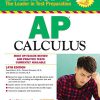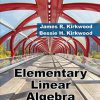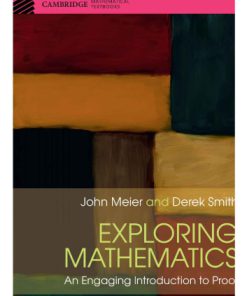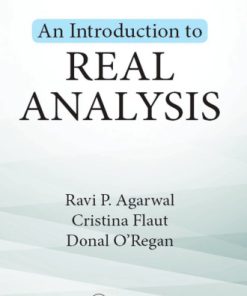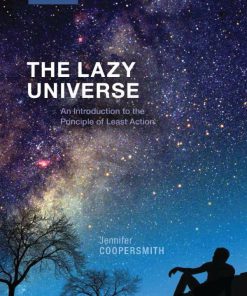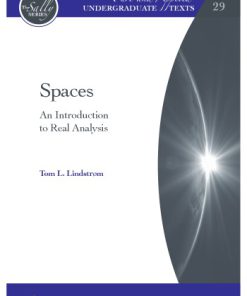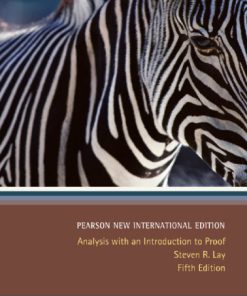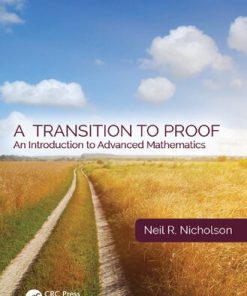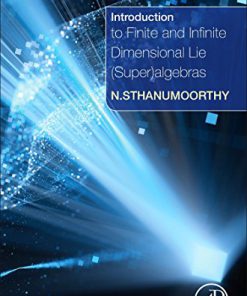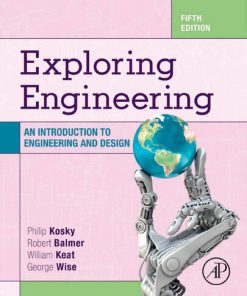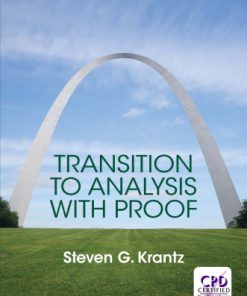Exploring the Infinite An Introduction to Proof and Analysis 1st Edition by Jennifer Brooks 1498704526 9781498704526
$50.00 Original price was: $50.00.$25.00Current price is: $25.00.
Exploring the Infinite An Introduction to Proof and Analysis 1st Edition by Jennifer Brooks – Ebook PDF Instant Download/DeliveryISBN: 1498704526, 9781498704526
Full download Exploring the Infinite An Introduction to Proof and Analysis 1st Edition after payment.
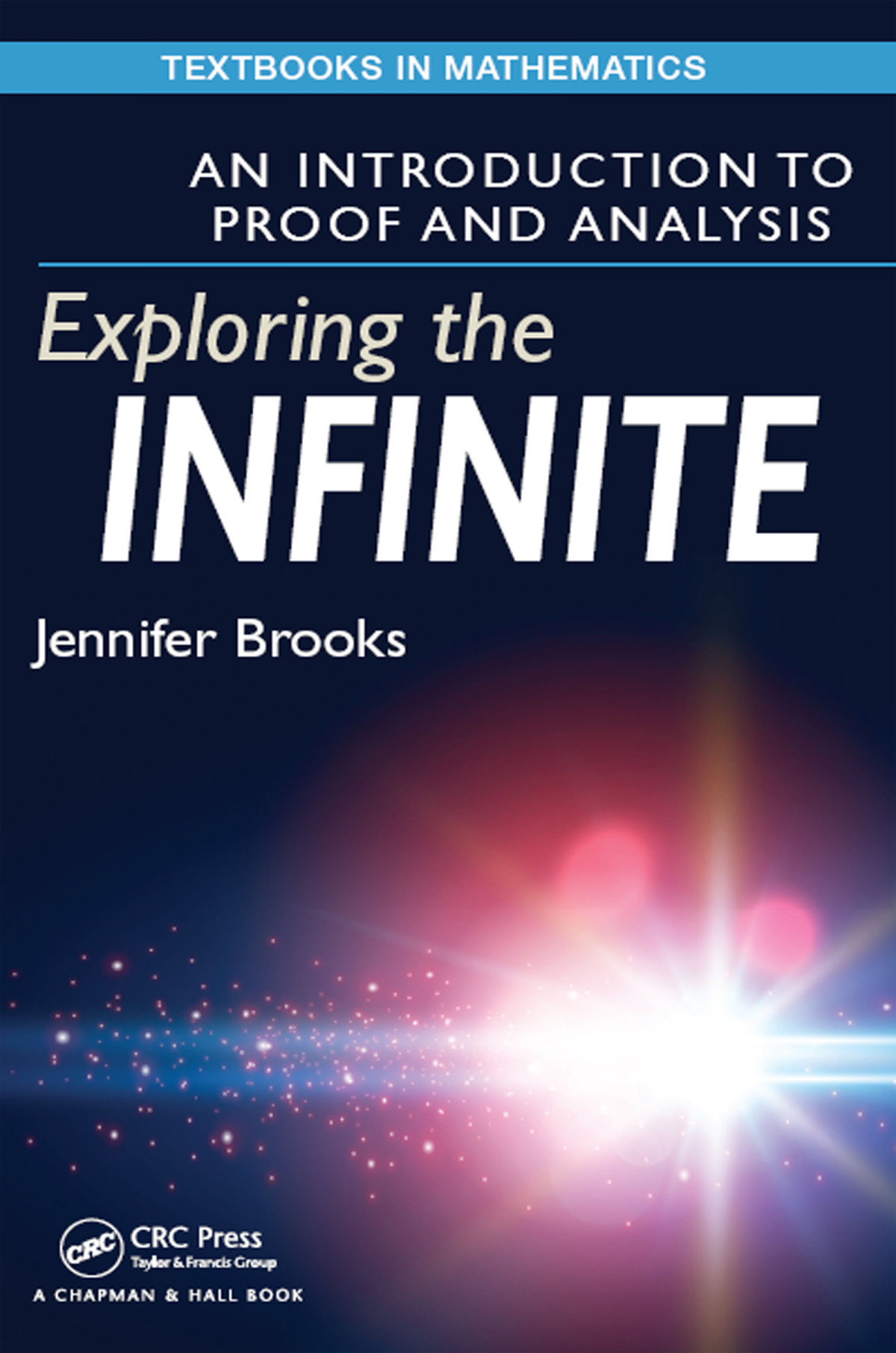
Product details:
ISBN-10 : 1498704526
ISBN-13 : 9781498704526
Author: Jennifer Brooks
Exploring the Infinite addresses the trend toward a combined transition course and introduction to analysis course. It guides the reader through the processes of abstraction and log- ical argumentation, to make the transition from student of mathematics to practitioner of mathematics. This requires more than knowledge of the definitions of mathematical structures, elementary logic, and standard proof techniques. The student focused on only these will develop little more than the ability to identify a number of proof templates and to apply them in predictable ways to standard problems. This book aims to do something more; it aims to help readers learn to explore mathematical situations, to make conjectures, and only then to apply methods of proof. Practitioners of mathematics must do all of these things. The chapters of this text are divided into two parts. Part I serves as an introduction to proof and abstract mathematics and aims to prepare the reader for advanced course work in all areas of mathematics. It thus includes all the standard material from a transition to proof” course. Part II constitutes an introduction to the basic concepts of analysis, including limits of sequences of real numbers and of functions, infinite series, the structure of the real line, and continuous functions. Features Two part text for the combined transition and analysis course New approach focuses on exploration and creative thought Emphasizes the limit and sequences Introduces programming skills to explore concepts in analysis Emphasis in on developing mathematical thought Exploration problems expand more traditional exercise sets
Exploring the Infinite An Introduction to Proof and Analysis 1st table of contents:
I Fundamentals of Abstract Mathematics
1 Basic Notions
1.1 A First Look at Some Familiar Number Systems
1.1.1 Integers and natural numbers
1.1.2 Rational numbers and real numbers
1.2 Inequalities
1.3 A First Look at Sets and Functions
1.3.1 Sets, elements, and subsets
1.3.2 Operations with sets
1.3.3 Special subsets of ℝ: intervals
1.3.4 Functions
1.4 Problems
2 Mathematical Induction
2.1 First Examples
2.1.1 Defining sequences through a formula for the n-th term
2.1.2 Defining sequences recursively
2.2 First Programs
2.3 First Proofs: Mathematical Induction
2.4 Strong Induction
2.5 The Well-Ordering Principle and Induction
2.6 Problems
3 Basic Logic and Proof Techniques
3.1 Logical Statements and Truth Tables
3.1.1 Statements and their negations
3.1.2 Combining statements
3.1.3 Implications
3.2 Quantified Statements and Their Negations
3.2.1 Writing implications as quantified statements
3.3 Proof Techniques
3.3.1 Direct proof
3.3.2 Proof by contradiction
3.3.3 Proof by contraposition
3.3.4 The art of the counterexample
3.4 Problems
4 Sets, Relations, and Functions
4.1 Sets
4.2 Relations
4.2.1 The definition
4.2.2 Order relations
4.2.3 Equivalence relations
4.3 Functions
4.3.1 Images and pre-images
4.3.2 Injections, surjections, and bijections
4.3.3 Compositions of functions
4.3.4 Inverse functions
4.4 Problems
5 Elementary Discrete Mathematics
5.1 Basic Principles of Combinatorics
5.1.1 The Addition and Multiplication Principles
5.1.2 Permutations and combinations
5.1.3 Combinatorial identities
5.2 Linear Recurrence Relations
5.2.1 An example
5.2.2 General results
5.3 Analysis of Algorithms
5.3.1 Some simple algorithms
5.3.2 O, Ω, and Θ notation
5.3.3 Analysis of the binary search algorithm
5.4 Problems
6 Number Systems; Algebraic Structures
6.1 Representations of Natural Numbers
6.1.1 Developing an algorithm to convert a number from base 10 to base 2
6.1.2 Proof of the existence and uniqueness of the base b representation of an element of ℕ
6.2 Integers and Divisibility
6.3 Modular Arithmetic
6.3.1 Definition of congruence and basic properties
6.3.2 Congruence classes
6.3.3 Operations on congruence classes
6.4 The Rational Numbers
6.5 Algebraic Structures
6.5.1 Binary operations
6.5.2 Groups
6.5.3 Rings and fields
6.6 Problems
7 Cardinality
7.1 The Definition
7.2 Finite Sets Revisited
7.3 Countably Infinite Sets
7.4 Uncountable Sets
7.5 Problems
II Foundations of Analysis
8 Sequences of Real Numbers
8.1 The Limit of a Sequence
8.1.1 Numerical and graphical exploration
8.1.2 The precise definition of a limit
8.2 Properties of Limits
8.3 Cauchy Sequences
8.3.1 Showing that a sequence is Cauchy
8.3.2 Showing that a sequence is divergent
8.3.3 Properties of Cauchy sequences
8.4 Problems
9 A Closer Look at the Real Number System
9.1 ℝ as a Complete Ordered Field
9.1.1 Completeness
9.1.2 Why ℚ is not complete
9.1.3 Algorithms for approximating 2
9.2 Construction of ℝ
9.2.1 An equivalence relation on Cauchy sequences of rational numbers
9.2.2 Operations on ℝ
9.2.3 Verifying the field axioms
9.2.4 Defining order
9.2.5 Sequences of real numbers and completeness
9.3 Problems
10 Series, Part
10.1 Basic Notions
10.1.1 Definitions
10.1.2 Exploring the sequence of partial sums graphically and numerically
10.1.3 Basic properties of convergent series
10.1.4 Series that diverge slowly: The harmonic series
10.2 Infinite Geometric Series
10.3 Tests for Convergence of Series
10.4 Representations of Real Numbers
10.4.1 Base 10 representation
10.4.2 Base 10 representations of rational numbers
10.4.3 Representations in other bases
10.5 Problems
11 The Structure of the Real Line
11.1 Basic Notions from Topology
11.1.1 Open and closed sets
11.1.2 Accumulation points of sets
11.2 Compact sets
11.2.1 Subsequences and limit points
11.2.2 First definition of compactness
11.2.3 The Heine–Borel property
11.3 A First Glimpse at the Notion of Measure
11.3.1 Measuring intervals
11.3.2 Measure zero
11.3.3 The Cantor set
11.4 Problems
12 Continuous Functions
12.1 Sequential Continuity
12.1.1 Exploring sequential continuity graphically and numerically
12.1.2 Proving that a function is continuous
12.1.3 Proving that a function is discontinuous
12.1.4 First results
12.2 Related Notions
12.2.1 The ε-δ condition
12.2.2 Uniform continuity
12.2.3 The limit of a function
12.3 Important Theorems
12.3.1 The Intermediate Value Theorem
12.3.2 Developing a root-finding algorithm from the proof of the IVT
12.3.3 Continuous functions on compact intervals
12.4 Problems
13 Differentiation
13.1 Definition and First Examples
13.2 Differentiation Rules
13.3 Applications of the Derivative
13.4 Problems
14 Series, Part
14.1 Absolute and Conditional Convergence
14.1.1 The first example
14.1.2 Summation by Parts and the Alternating Series Test
14.1.3 Basic facts about conditionally convergent series
14.2 Rearrangements
14.2.1 Rearrangements and non-negative series
14.2.2 Using Python to explore the alternating harmonic series
14.2.3 A general theorem
14.3 Problems
People also search for Exploring the Infinite An Introduction to Proof and Analysis 1st:
exploring the unknown in science
explore the infinite
exploring the unknown in history
exploring philosophy an introductory anthology pdf
exploring the infinite
Tags: Exploring, the Infinite, Introduction, Jennifer Brooks
You may also like…
Science (General)
Mathematics
Spaces An Introduction to Real Analysis 1st edition by Tom Lindstrom ISBN 1470440628 9781470440626
Mathematics - Analysis
Science (General)
Science (General)
Engineering - Engineering - General & Miscellaneous
Exploring Engineering: An Introduction to Engineering and Design Philip Kosky
Science (General)


